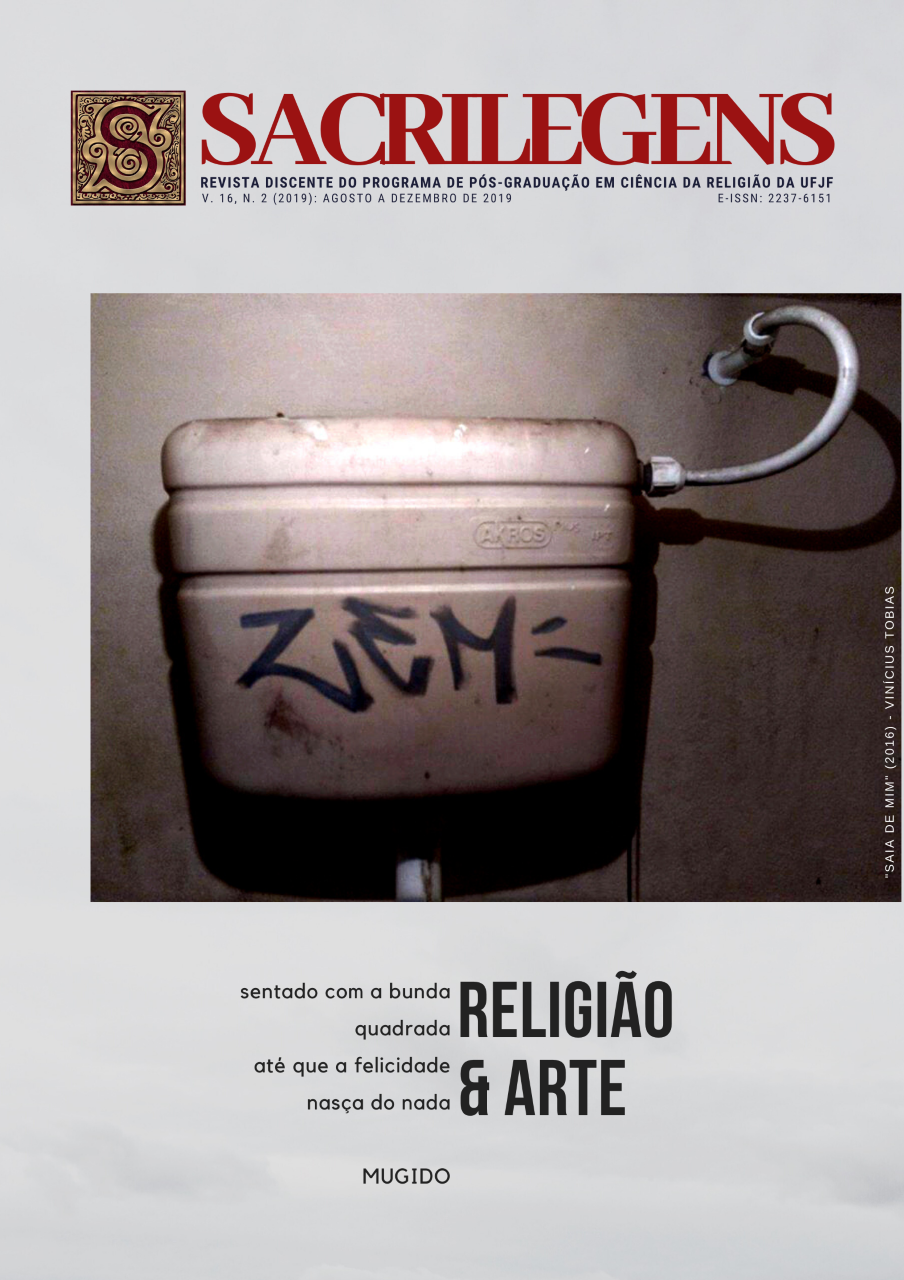A religiosidade na obra de Theo Angelopoulos
aspectos da transcendência em A eternidade e um dia (1998)
DOI:
https://doi.org/10.34019/2237-6151.2019.v16.29065Keywords:
Religião. Arte. Cinema. Angelopoulos.Abstract
Theo Angelopoulos´ later work, developed in the 1990s, in addition to its political characteristics, has a religious bias that is still poorly understood. The purpose of this article is to analyze how this religiosity presents itself in the narrative of the Greek filmmaker. We'll support authors such as Mircea Eliade, Michael Bahktin, Gerard Genette, and Jan Albert. As an example we will use the film Eternity and a Day (Mia aioniotita kai mia mera, 1998).
Downloads
References
ANDREW, Geoff. Theo Angelopoulos: the sweep of history. Sight and Sound, 2012. Disponível em http://old.bfi.org.uk/sightandsound/feature/49816. Acesso em 10/12/2018
AGEL, Henri. O cinema tem alma? Belo Horizonte: Itatiaia 1963.
BAKHTIN, M. Formas de tempo e de cronotopo no romance. Ensaio de poética histórica, in: Questões de literatura e de estética. A teoria do romance. São Paulo: UNESP, 2010.
BAKHTIN, M. Estética da criação verbal. São Paulo: Martins Fontes, 2003.
BARONI, Raphaël; REVAZ, Françoise. Narrative Sequence in Contemporary Narratology. Ohio: The Ohio State University, 2016.
BORDWELL, David. Narration in the Fiction Film. Wisconsin: University of Wisconsin Press, 1986.
BORDWELL, David; THOMPSOM, Kristin Scott. Film Art: An introduction. 5 ed. Wisconsin: University of Wisconsin, 1997.
CAILLOIS, Roger. O Homem e o sagrado. Lisboa: Edições 70, 1950.
CIMENT, Michel. The State of Cinema. Unspoken Cinema, 2003. Disponível em: http://unspokencinema.blogspot.com/2006/10/state-of-cinema-m-ciment.html. Acesso em 10/12/2018.
ELIADE, Mircea. História das crenças e das ideias religiosas – Vol. 1. Rio de Janeiro: Zahar, 2010.
ELIADE, Mircea. O Sagrado e o Profano. São Paulo: Martins Fontes, 1995.
ELIADE, Mircea. Mito e realidade. São Paulo: Perspectiva, 1998.
FLANAGAN, M. Bakhtin and the Movies. New Ways of Understanding Hollywood Film. Londres: Palgrave Macmilln, 2009.
FLANAGAN, Matthew. Towards an Aesthetic of Slow in Contemporary Cinema. 16:9, nov. 2008. Disponível em: http://www.16-9.dk/2008-11/side11_inenglish.html. Acesso em 10/12/2018.
GANSER, A.; PÜHRINGER, J.; RHEINDORF, M. Bakhtin's chronotope on the road: Space, time, and place in road movies since the 1970s. Linguistics and Literature Vol. 4, No 1, 2006, pp. 1 – 17.
GAUDREAULT, Andre. & JOST, François. A narrativa cinematográfica. Brasília: UnB, 2009.
GENETTE, Gerard. Figures III. Paris: Éditions du Seuil, 1972.
GENETTE, Gerard. O Discurso da Narrativa. 3 ed. Lisboa: Veiga, 1995.
GOMBRICH, Ernst Hans. A história da arte. Rio de Janeiro: LTC, 2012.
HERMAN, David. Limits of Order: Toward a Theory of Polychronic Narration. Narrative 6, 72–95. 1998.
HOBSBAWM, Eric J. A era dos extremos: o breve século XX: 1914-1991. Trad. Marcos Santarrita. Rev. Tec. Maria Célia Paoli. São Paulo: Companhia das Letras, 2002.
HORTON, Andrew. The Films of Theo Angelopoulos: a Cinema of Contemplation. Princeton: Princeton University Press, 1997.
HORTON, Andrew. The Last Modernist: the Films of Theo Angelopoulos. Trowbridge: Flicks Books, 1997.
KOUTSOURAKIS, Angelo & STEVEN, Mark. The Cinema of Theo Angelopoulos. Edinburgo: Edinburgh University Press, 2015.
KRISTEVA, Julia. Estrangeiros para nós mesmos. Trad. Maria Carlota Carvalho Gomes. Rio de Janeiro: Rocco, 1994.
MUNSTERBERG, Hugo. A memória e a imaginação. In: XAVIER, Ismail (org). A experiência do cinema. Rio de Janeiro: Edições Graal, 1991.
ORICHIO, Luiz Zanin. O cinema humanista de Theo Angelopoulos. Disponível em https://cultura.estadao.com.br/blogs/luiz-zanin/o-cinema-humanista-de-theo-angelopoulos/. Acesso em 20/04/2019.
PIEPER, Frederico. Religião e Cinema. São Paulo: Fonte Editorial, 2015.
SCHRADER, Paul. Transcendental Style in Film: Ozu, Bresson, Dreyer. Berkeley. University of California Press, 1972.
STAM, Robert. Introdução à teoria do cinema. São Paulo: Papiros, 2003.
VANOYE, Francis; GOLLIOT-LÉTÉ, A. Ensaio sobre a Análise Fílmica. Campinas: Papirus, 1994.
6. Filmografia
A Eternidade e um dia. Direção: Theo Angelopoulos. São Paulo: Versátil Home Vídeo, 1998. 132 min., VHS, som, cor, legendado. (Material digitalizado).
Downloads
Published
How to Cite
Issue
Section
License
 Sacrilegens is licensed under a Creative Commons Attribution 4.0 International License.
Sacrilegens is licensed under a Creative Commons Attribution 4.0 International License.










